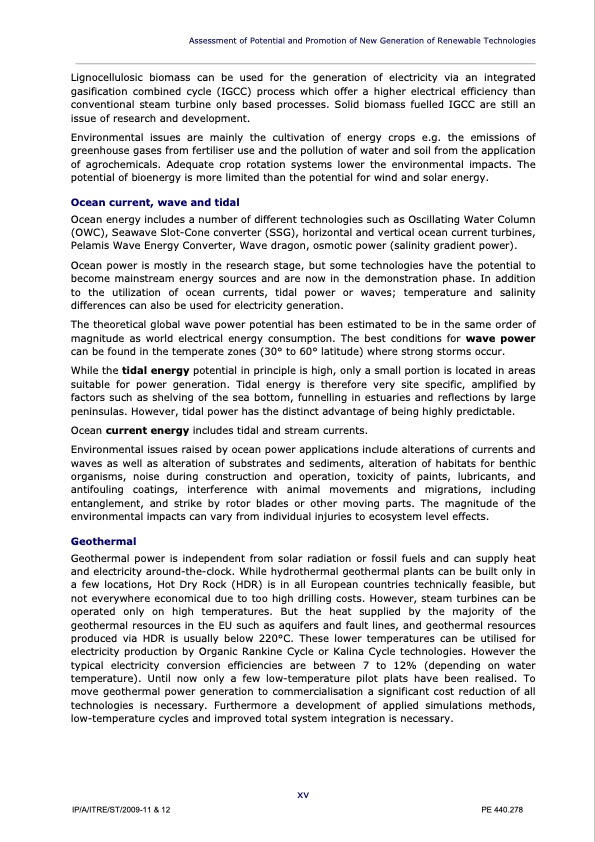
PDF Publication Title:
Text from PDF Page: 017
Assessment of Potential and Promotion of New Generation of Renewable Technologies ____________________________________________________________________________________________ Lignocellulosic biomass can be used for the generation of electricity via an integrated gasification combined cycle (IGCC) process which offer a higher electrical efficiency than conventional steam turbine only based processes. Solid biomass fuelled IGCC are still an issue of research and development. Environmental issues are mainly the cultivation of energy crops e.g. the emissions of greenhouse gases from fertiliser use and the pollution of water and soil from the application of agrochemicals. Adequate crop rotation systems lower the environmental impacts. The potential of bioenergy is more limited than the potential for wind and solar energy. Ocean current, wave and tidal Ocean energy includes a number of different technologies such as Oscillating Water Column (OWC), Seawave Slot-Cone converter (SSG), horizontal and vertical ocean current turbines, Pelamis Wave Energy Converter, Wave dragon, osmotic power (salinity gradient power). Ocean power is mostly in the research stage, but some technologies have the potential to become mainstream energy sources and are now in the demonstration phase. In addition to the utilization of ocean currents, tidal power or waves; temperature and salinity differences can also be used for electricity generation. The theoretical global wave power potential has been estimated to be in the same order of magnitude as world electrical energy consumption. The best conditions for wave power can be found in the temperate zones (30° to 60° latitude) where strong storms occur. While the tidal energy potential in principle is high, only a small portion is located in areas suitable for power generation. Tidal energy is therefore very site specific, amplified by factors such as shelving of the sea bottom, funnelling in estuaries and reflections by large peninsulas. However, tidal power has the distinct advantage of being highly predictable. Ocean current energy includes tidal and stream currents. Environmental issues raised by ocean power applications include alterations of currents and waves as well as alteration of substrates and sediments, alteration of habitats for benthic organisms, noise during construction and operation, toxicity of paints, lubricants, and antifouling coatings, interference with animal movements and migrations, including entanglement, and strike by rotor blades or other moving parts. The magnitude of the environmental impacts can vary from individual injuries to ecosystem level effects. Geothermal Geothermal power is independent from solar radiation or fossil fuels and can supply heat and electricity around-the-clock. While hydrothermal geothermal plants can be built only in a few locations, Hot Dry Rock (HDR) is in all European countries technically feasible, but not everywhere economical due to too high drilling costs. However, steam turbines can be operated only on high temperatures. But the heat supplied by the majority of the geothermal resources in the EU such as aquifers and fault lines, and geothermal resources produced via HDR is usually below 220°C. These lower temperatures can be utilised for electricity production by Organic Rankine Cycle or Kalina Cycle technologies. However the typical electricity conversion efficiencies are between 7 to 12% (depending on water temperature). Until now only a few low-temperature pilot plats have been realised. To move geothermal power generation to commercialisation a significant cost reduction of all technologies is necessary. Furthermore a development of applied simulations methods, low-temperature cycles and improved total system integration is necessary. IP/A/ITRE/ST/2009-11 & 12 PE 440.278 xvPDF Image | Policy Department Renewable Technologies

PDF Search Title:
Policy Department Renewable TechnologiesOriginal File Name Searched:
IPOL_ITRE_ET(2010)440278_EN.pdfDIY PDF Search: Google It | Yahoo | Bing
NFT (Non Fungible Token): Buy our tech, design, development or system NFT and become part of our tech NFT network... More Info
IT XR Project Redstone NFT Available for Sale: NFT for high tech turbine design with one part 3D printed counter-rotating energy turbine. Be part of the future with this NFT. Can be bought and sold but only one design NFT exists. Royalties go to the developer (Infinity) to keep enhancing design and applications... More Info
Infinity Turbine IT XR Project Redstone Design: NFT for sale... NFT for high tech turbine design with one part 3D printed counter-rotating energy turbine. Includes all rights to this turbine design, including license for Fluid Handling Block I and II for the turbine assembly and housing. The NFT includes the blueprints (cad/cam), revenue streams, and all future development of the IT XR Project Redstone... More Info
Infinity Turbine ROT Radial Outflow Turbine 24 Design and Worldwide Rights: NFT for sale... NFT for the ROT 24 energy turbine. Be part of the future with this NFT. This design can be bought and sold but only one design NFT exists. You may manufacture the unit, or get the revenues from its sale from Infinity Turbine. Royalties go to the developer (Infinity) to keep enhancing design and applications... More Info
Infinity Supercritical CO2 10 Liter Extractor Design and Worldwide Rights: The Infinity Supercritical 10L CO2 extractor is for botanical oil extraction, which is rich in terpenes and can produce shelf ready full spectrum oil. With over 5 years of development, this industry leader mature extractor machine has been sold since 2015 and is part of many profitable businesses. The process can also be used for electrowinning, e-waste recycling, and lithium battery recycling, gold mining electronic wastes, precious metals. CO2 can also be used in a reverse fuel cell with nafion to make a gas-to-liquids fuel, such as methanol, ethanol and butanol or ethylene. Supercritical CO2 has also been used for treating nafion to make it more effective catalyst. This NFT is for the purchase of worldwide rights which includes the design. More Info
NFT (Non Fungible Token): Buy our tech, design, development or system NFT and become part of our tech NFT network... More Info
Infinity Turbine Products: Special for this month, any plans are $10,000 for complete Cad/Cam blueprints. License is for one build. Try before you buy a production license. May pay by Bitcoin or other Crypto. Products Page... More Info
| CONTACT TEL: 608-238-6001 Email: greg@infinityturbine.com | RSS | AMP |